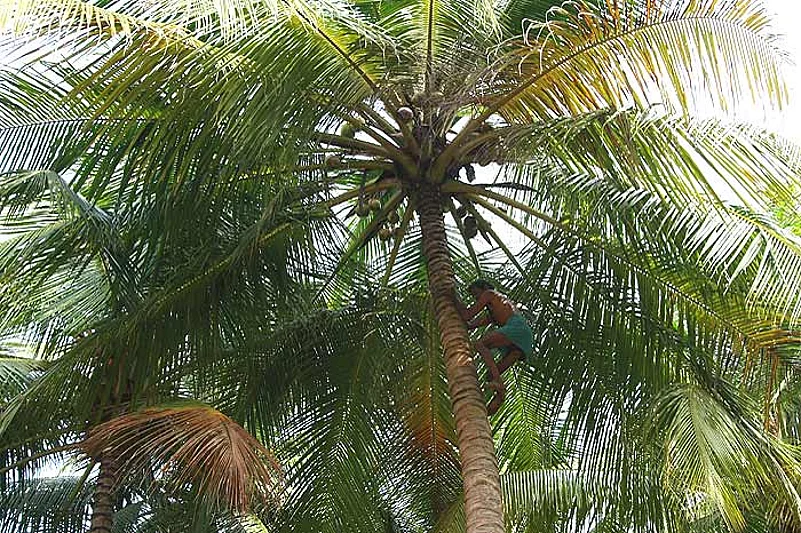Kerala faces a nutty problem. The state is in desperate need of coconut palm climbers and its government is now willing to do whatever it takes: give this age-old profession a modern makeover, give it respectability or even give it another name—whatever will get people to shin up the lofty palms and send the nuts hurtling to the ground. The state needs approximately 40,000 more climbers to harvest the entirety of its coconut produce annually. For 3,000 years, rigid tradition had assigned the task to certain communities: the father climbed up the coconut palm and so did his son, for generations on down. But all that has now changed. The tree climber has all but vanished. They have moved on to professions that are more grounded, less risky and do not involve suspending oneself by a knotted rope a hundred feet up for most of the workday.
Advertisement
Kerala’s religiosity, its cuisine, its skin and, yes, even its soul is steeped in the coconut’s oil, pulp and milk. Hardly surprising given that its landscape is so lavishly embellished with the lofty palm. It is still rare to find a house without a coconut palm in its courtyard. R.Venkitasubramanian has three trees in his compound in Mattancherry, west Kochi. For the past five or six years, he has faced a predicament unthinkable in earlier times: hunting for a climber. The coconut palm needs to be plucked six to eight times a year. Ideally, the coconuts should be plucked, the ripe palm fronds cut and the crown of the tree cleaned every 45 days. The trees also need to be checked for diseases and insects. “But now, we have to search high and low for a climber and once in six months, we literally drag one here and beg him to climb the trees. Neighbours complain when the ripe coconuts fall on their roofs and break their tiles, but I am reluctant to fell the trees,” says Venkitasubramanian. Thrissur-based Manappuram Agro Farms (MAF) took out an ad in a local newspaper, offering a salary of Rs 15,000 per month for climbers. “There is a scarcity of coconut tree climbers. Our farm with 3,500 trees needs people on a permanent basis. Besides the coconut plucking, the trees need to be kept disease-free too,” says Girija Vallabhan, MAF assistant general manager.
Advertisement
The coconut climber can command much more for his services these days—Rs 50 per tree in cities like Kochi and Rs 20-30 in rural areas. A climber can attend to 150 trees daily if he uses the tree-climbing device (see box). With the traditional rope method, he can still clamber up 75 trees. But even at these rates, very few climbers are willing to take up the job. And with good reason. “I began to climb trees at the age of 10. The wages back then were just 75 paise per tree. We start at 6 am and would climb till about 11 am because the trunk becomes very hot after that and we’d get blisters on our legs and hands. We can climb only 70 trees per day. Now the wages have gone up and there is a machine too. But it is still a difficult task and that is the reason why the younger generation of traditional climbers have sought other jobs,” says Aji, an old hand at scaling palms, who’s pushing forty.
The dearth of coconut climbers has delayed harvesting in many places and, some coconut farmers say, has affected productivity too. Traditional climbers not only plucked coconuts but also took care of the trees and kept them free of disease. Kerala, of course, is India’s largest coconut producer with 5,667 million nuts in 2009-10. But the production this year has witnessed a sharp decline: nearly 135 million fewer nuts, according to the agriculture ministry. To an extent, the scarcity of climbers has affected the coconut oil and coir industries too. Says Shine K.R., director of Keratech, which produces both regular and virgin coconut oil, “We use fresh coconuts and not copra for virgin oil. We prefer the nuts from the coastal areas because of the higher oil content. There is a shortage of nuts because the availability of coconut tree climbers is irregular. They come once in 3-4 months and this, of course, affects our procurement logistics.” Agrees K.V. Sharath Chandran, project officer at a Vaikom-based coir plant, “Now, the fibre is made from green husk as opposed to the retting process. It’s necessary that the coconut be harvested in the 45-day period and that we get the husk within 3-4 days or the golden colour is lost. Because of delayed harvesting, the nut dries on the tree itself.”
Advertisement
To tackle the crisis, the Coconut Development Board (CDB) has intervened on a war footing. Since the middle of August, the board has conducted free residential weekly training programmes in 12 centres in Kerala, called ‘Friends of Coconut Tree’. “We’ve allotted Rs 3 crore for training till March 2012 and expect to train about 5,000 climbers to not only pluck coconuts but also identify diseases and spot seeds,” says Thomas Mathew, chief coconut development officer, CDB. The board is training these people in the use of the tree climbing machine and has distributed free track suit kits, jerseys, caps and a Rs 900 stipend to give the job a patina of respectability. The use of climbing machines has another advantage: it lets women enter the traditionally male-dominated profession. Sandya was one of the first women to train under this initiative. “I thought the trees would be just 40-feet-high, but they’re much taller. I’ve always enjoyed sports so I don’t mind the height. And the money’s quite decent. Even if I climb only three trees, I get Rs 100,” says Sandya. Coconut plantation owners, as well as residents with coconut palms in their courtyards, will be hoping the new crop of climbers learns the ropes quickly.



















